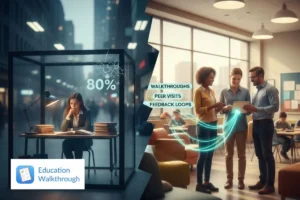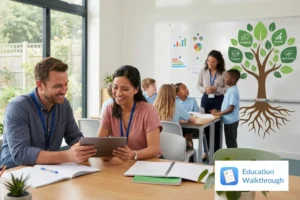Giving feedback is an incredibly crucial skill for school principals. Constructive feedback has the power to shape and improve teaching practices, foster professional growth, and ultimately enhance student learning. In this article, we will explore various strategies that principals can employ to craft feedback that is both valuable and impactful.
Understanding the Importance of Constructive Feedback
Constructive feedback is more than just pointing out areas of improvement. It involves providing specific and actionable suggestions for growth while acknowledging strengths. Principals must understand that feedback is an opportunity for growth, not a critique. By conveying this understanding to teachers, principals can create a culture where feedback is embraced and valued.
One way to demonstrate the importance of constructive feedback is by sharing success stories where teachers have implemented feedback and witnessed positive outcomes. By highlighting these examples, principals can inspire teachers and create a sense of enthusiasm towards the feedback process.
Furthermore, constructive feedback plays a crucial role in professional development. It allows educators to reflect on their practices, identify areas for improvement, and enhance their teaching strategies. Through ongoing feedback, teachers can continuously refine their skills and adapt to the evolving needs of their students, ultimately leading to improved academic outcomes.
Additionally, constructive feedback fosters a culture of collaboration and continuous learning within a school community. When feedback is given and received constructively, it encourages open communication, trust, and mutual respect among educators. This collaborative environment not only benefits individual teachers in their professional growth but also contributes to the overall success and effectiveness of the school as a whole.
Tailoring Feedback to Individual Teachers
Each teacher is unique, with their own set of strengths and areas for growth. Principals must tailor feedback to meet the specific needs of individual teachers. This requires careful observation and ongoing dialogue to gain a deep understanding of each teacher’s instructional practices.
When providing feedback, principals should be clear and specific. Instead of giving generic feedback, principals should highlight specific examples of effective strategies or areas that require improvement. By focusing on the individual teacher’s strengths and growth areas, principals can provide targeted support that enables teachers to develop their pedagogical skills.
Furthermore, it is essential for principals to consider the diverse learning styles and preferences of teachers when delivering feedback. Some teachers may respond well to constructive criticism in a group setting, while others may prefer one-on-one feedback sessions. Understanding how each teacher best receives feedback can enhance the effectiveness of the support provided.
Additionally, principals should encourage a growth mindset among teachers, emphasizing that feedback is not a critique of their abilities but rather an opportunity for continuous improvement. By fostering a culture of open communication and collaboration, principals can create a supportive environment where teachers feel empowered to reflect on their practice and make meaningful changes to enhance student learning outcomes.
Creating a Culture of Feedback in Schools
In order to effectively craft feedback, principals must foster a culture of feedback within their schools. This can be achieved by setting clear expectations and norms around feedback and creating opportunities for collaboration and reflection.
One way to create a culture of feedback is through the implementation of peer observation and feedback protocols. By encouraging teachers to observe and provide feedback to their colleagues, principals can create a supportive environment where feedback is seen as a valuable tool for professional growth.
Additionally, principals should provide regular opportunities for teachers to reflect on their teaching practices and engage in discussions around their professional goals. By creating a safe and supportive space for teachers to share their challenges and successes, principals can cultivate a community of continuous learning and improvement.
Furthermore, fostering a culture of feedback in schools involves recognizing the importance of student feedback. Principals can encourage teachers to seek feedback from students through surveys, focus groups, or one-on-one conversations. This student feedback can provide valuable insights into teaching effectiveness and help educators tailor their approaches to better meet the needs of their students.
Another effective strategy for promoting a culture of feedback is to celebrate and acknowledge feedback efforts. Principals can publicly recognize and appreciate teachers and staff members who actively seek and provide feedback, creating a positive feedback loop that encourages ongoing participation and engagement.
Overcoming Challenges in Giving Constructive Feedback
Giving feedback can be challenging, especially when addressing areas of improvement. However, with the right strategies, principals can overcome these challenges and ensure that feedback is delivered in a constructive and supportive manner.
One strategy is to use the “sandwich” approach, where constructive feedback is sandwiched between positive comments. This helps to soften the impact of criticism and maintain a positive rapport with the teacher. Additionally, principals should use language that focuses on specific behaviors or actions rather than personal characteristics, which reduces defensiveness and fosters a growth mindset.
Furthermore, principals should provide ongoing support and resources to help teachers implement the feedback. By offering professional development opportunities, instructional materials, or peer mentorship, principals can ensure that teachers have the necessary tools and support to address areas of growth.
Another effective strategy for giving constructive feedback is to schedule regular check-ins with teachers to discuss progress and provide guidance. These check-ins can serve as a platform for open communication and collaboration, allowing teachers to share their challenges and successes in implementing feedback.
Moreover, principals can encourage a culture of continuous improvement by celebrating small victories and milestones along the way. Recognizing and acknowledging teachers’ efforts to address feedback can boost morale and motivation, creating a positive feedback loop for professional growth.
Empowering Teachers Through Feedback
Feedback should not be seen as a one-way process but rather as a collaborative effort to enhance teaching and learning. Principals must empower teachers to take ownership of their growth and development by involving them in the feedback process.
Principals can encourage teachers to self-reflect on their instructional practices and goals, allowing them to identify areas for improvement and potential solutions. By involving teachers in the feedback process, principals foster a sense of ownership and autonomy, which leads to greater motivation and engagement in professional growth.
Furthermore, when teachers are actively engaged in the feedback process, they are more likely to feel valued and respected by their school leadership. This sense of respect can have a ripple effect throughout the school community, fostering a positive and collaborative environment where teachers feel supported in their professional development.
Additionally, by involving teachers in setting their own professional goals based on feedback, principals can tailor support and resources to meet individual needs. This personalized approach not only enhances teacher effectiveness but also contributes to a culture of continuous improvement within the school.
Continuous Improvement: Evolving Feedback Practices
Feedback practices should not remain stagnant but rather evolve and adapt to the changing needs of teachers and students. Principals should regularly reflect on their feedback practices and seek input from teachers to ensure that the feedback is meaningful and relevant.
Principals can engage in professional learning networks and attend conferences or workshops focused on effective feedback strategies. By staying informed about current research and best practices, principals can continuously refine their feedback approaches and enhance their ability to support teacher growth.
Furthermore, it is crucial for principals to create a culture of open communication within the school community. Encouraging teachers to provide feedback on the feedback they receive can lead to valuable insights and improvements in the feedback process. This two-way feedback loop fosters collaboration and trust among educators, ultimately benefiting the entire school environment.
Another effective way for principals to enhance their feedback practices is by implementing technology tools that facilitate timely and constructive feedback. Utilizing online platforms or apps can streamline the feedback process, making it easier for principals to provide feedback in a timely manner and for teachers to access and reflect on the feedback received. Embracing technology in feedback practices can also help principals track progress over time and identify trends to inform future feedback strategies.
Building Trust Through Effective Feedback
Trust is the cornerstone of any successful feedback process. It serves as the bedrock upon which meaningful growth and development can occur. Principals play a crucial role in fostering this trust with their teachers, as it sets the tone for a collaborative and supportive learning environment.
One key strategy to cultivate trust is by establishing open lines of communication. Principals should not only provide feedback but also encourage a two-way dialogue where teachers feel empowered to share their thoughts and ideas. This exchange of perspectives fosters mutual respect and understanding, laying a solid foundation for a productive feedback loop.
Furthermore, building trust involves recognizing and celebrating the strengths of each teacher. Principals should take the time to acknowledge the unique talents and contributions of their staff members. By highlighting these strengths, principals not only boost teacher morale but also demonstrate a genuine appreciation for their hard work and dedication.
Another vital aspect of trust-building is fostering a culture of continuous improvement. Principals should emphasize that feedback is not about pointing out flaws but rather about identifying areas for growth and development. This growth mindset encourages teachers to view feedback as a valuable tool for honing their skills and enhancing their practice.
Summary
Crafting feedback that is constructive is an art that principals can master. By understanding the importance of constructive feedback, tailoring feedback to individual teachers, and creating a culture of feedback in schools, principals can empower teachers and foster continuous growth. Overcoming challenges, evolving feedback practices, and building trust are all crucial components of effective feedback. By implementing these strategies, principals can ensure that feedback becomes a catalyst for teacher development, ultimately positively impacting student learning.





